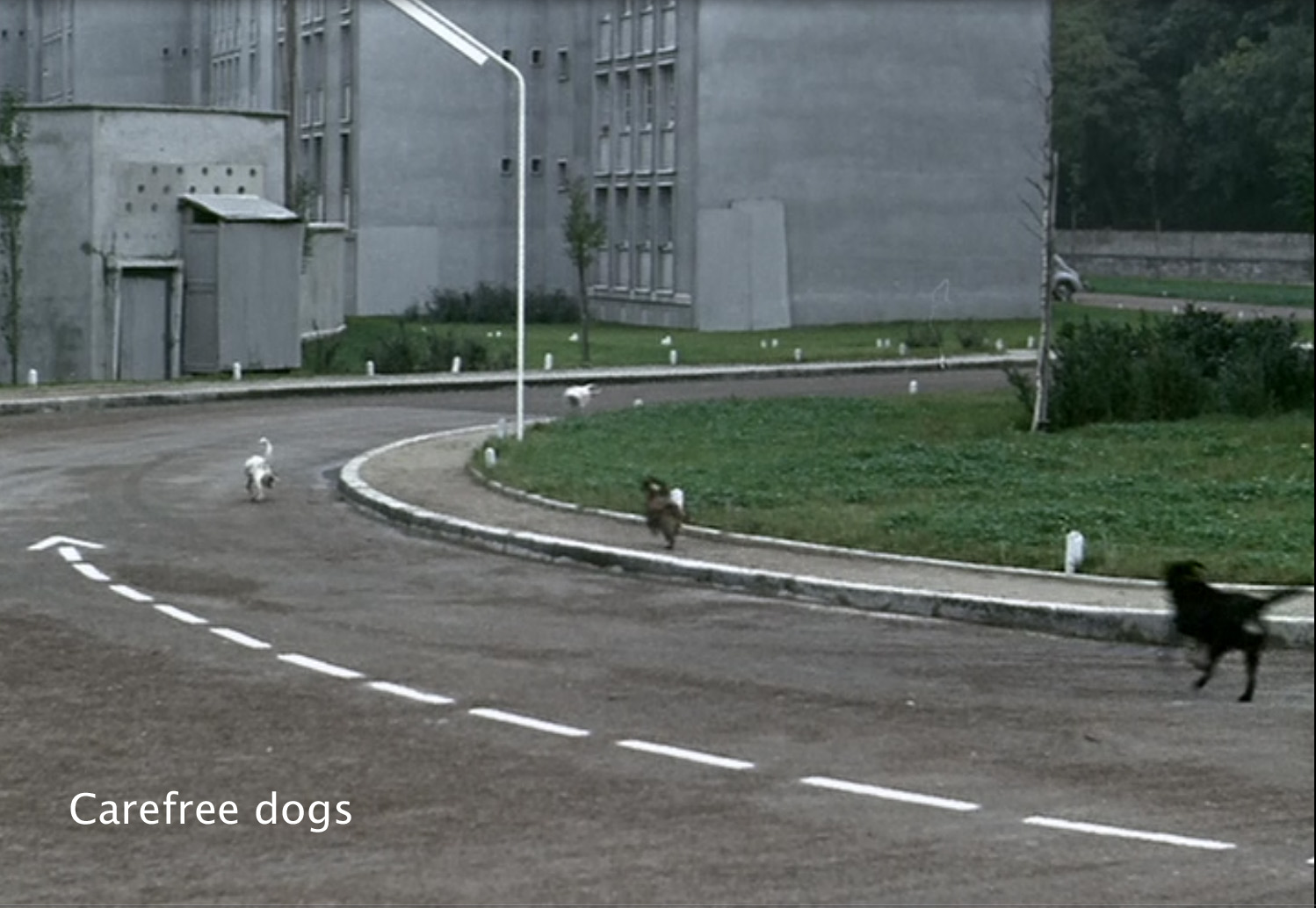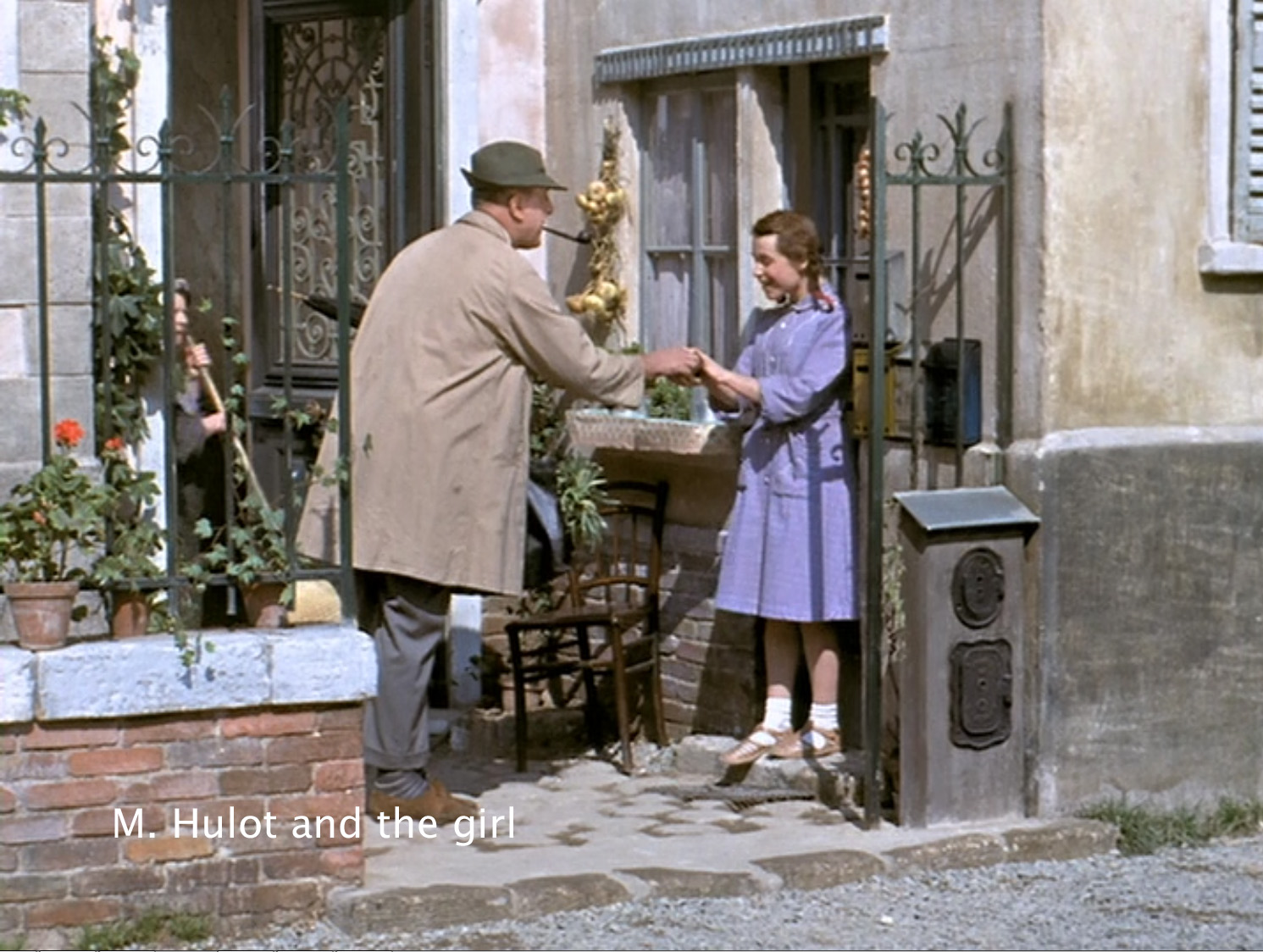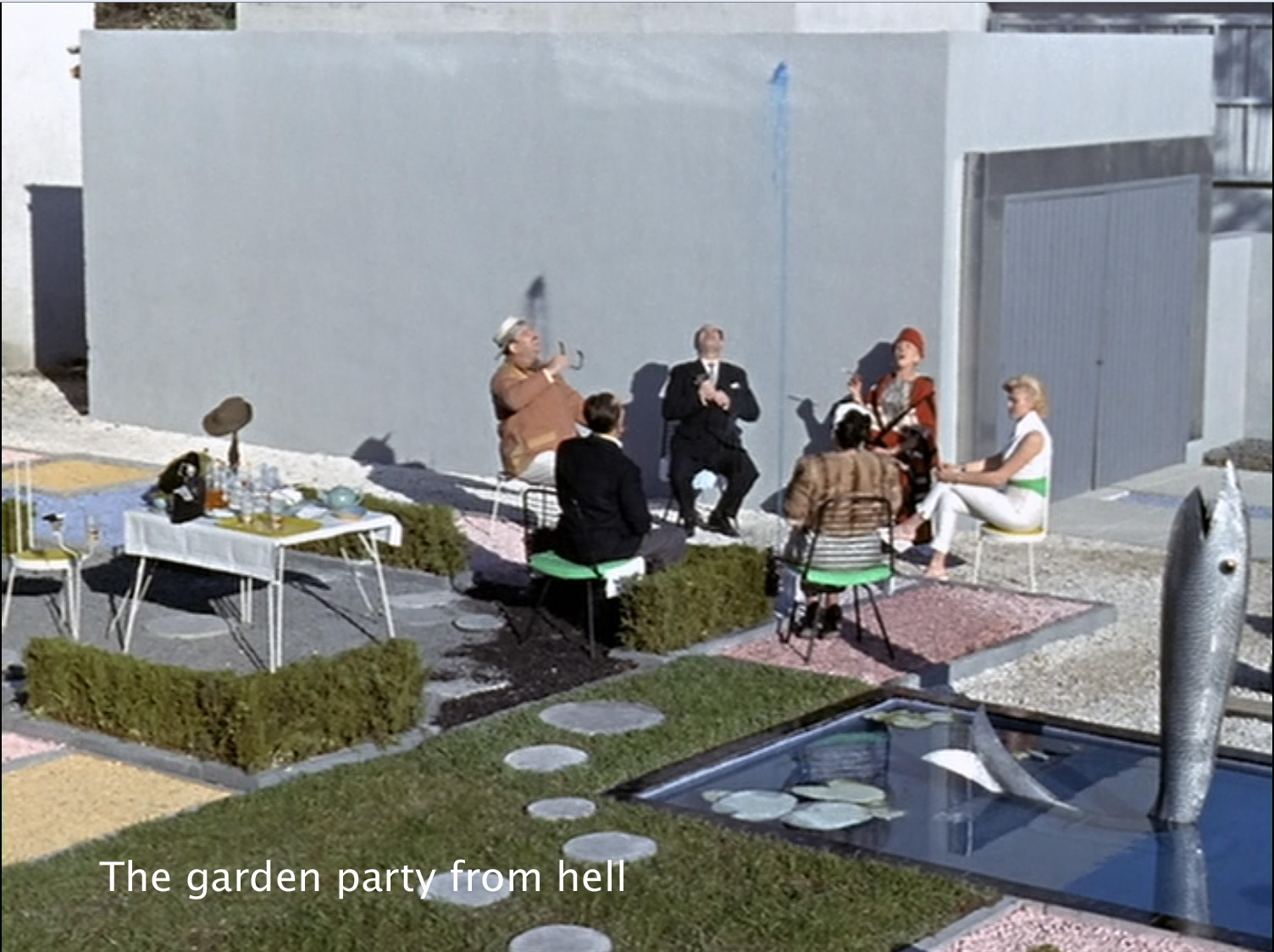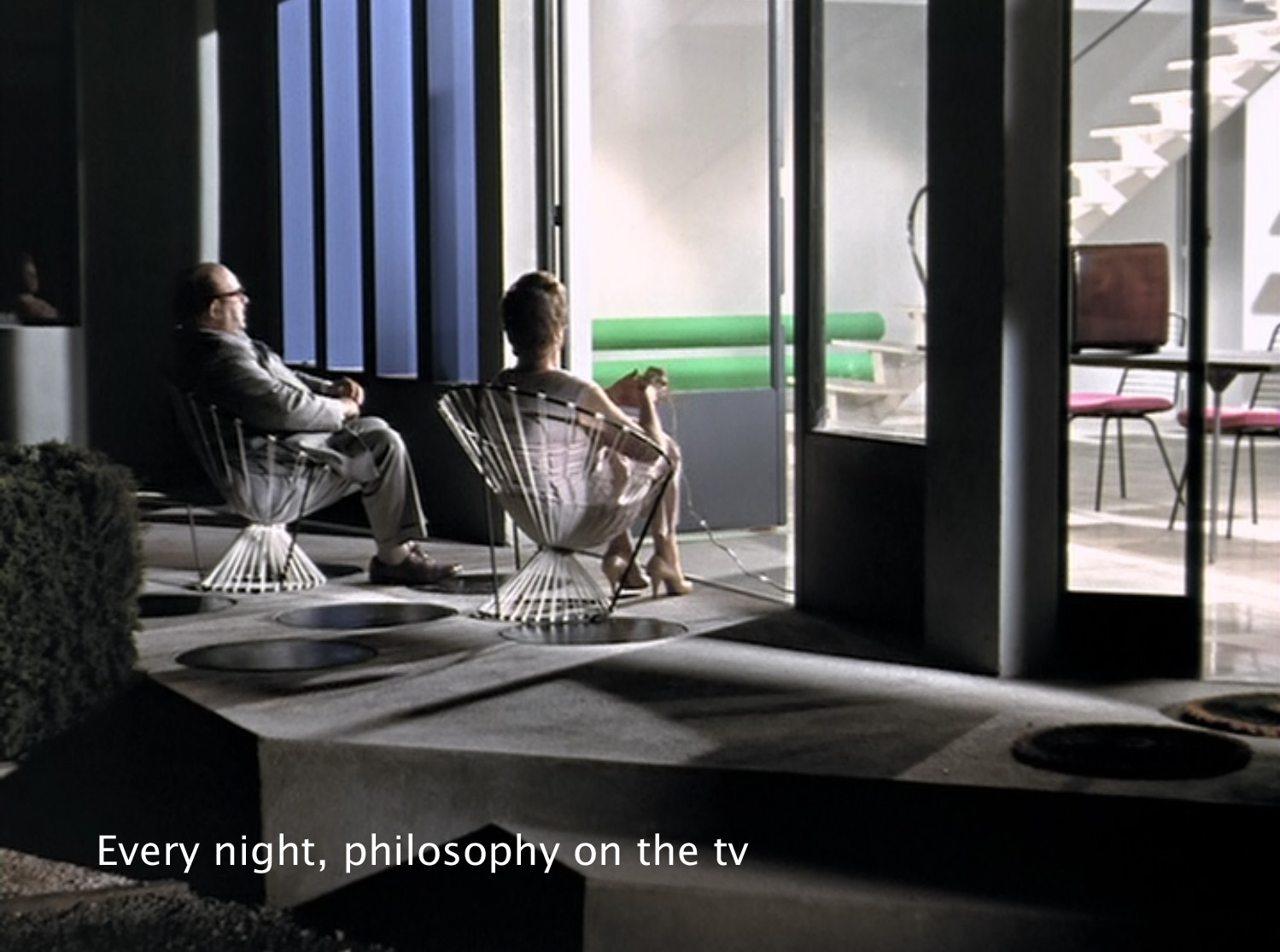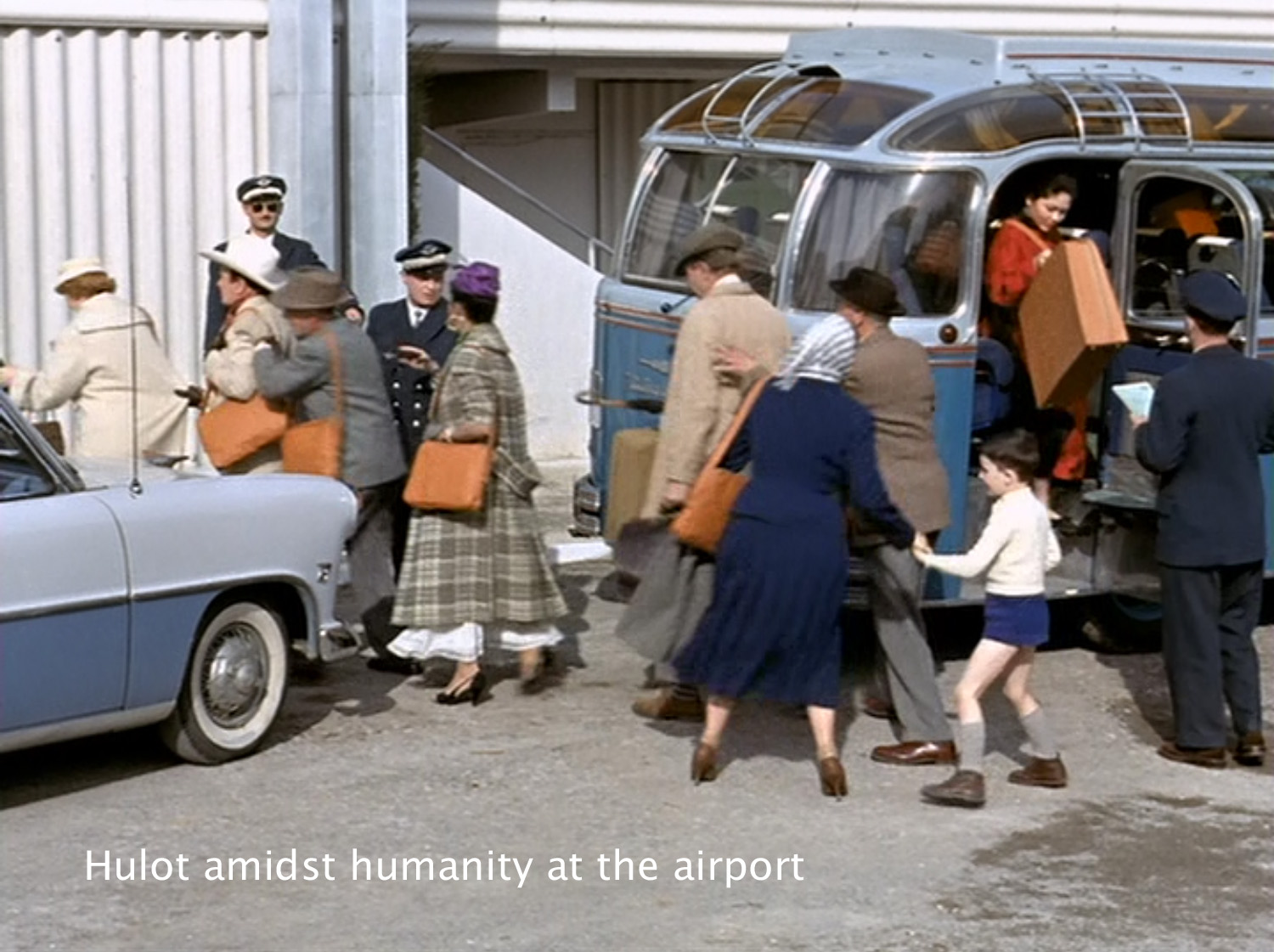In Mon Oncle, M. Hulot, played by Jacques Tati himself, comes into his own, even more than in M. Hulot’s Holiday. But here he looks the same curious figure throughout—no change of costume. He wears a raincoat with no jacket underneath. His trousers are too short, revealing his ridiculous socks. And, of course, he carries in his mouth the pipe that renders him as silent as Chaplin in this movie.
Tati builds his farce on the contrast between two worlds, a contrast that would seem too obvious if Tati were not one of the subtlest of filmmakers. One world is the hypermodern villa of the Arpels and the factories and businesses associated with it. The other is the almost mythically “Parisian” neighborhood where Hulot lives—let’s be appropriately French and call it the quartier.
One is the world of a dystopic future, and the other is a disappearing past. One world is repetitive, constrained, and formal, and the other is none of these things. Or you could simply say that Tati plays off a world of fun people as against a world of un-fun people.
You can see the contrast interestingly in the colors. (Tati loved to play with color, as in the last frame of M. Hulot’s Holiday.) For the Arpel-world, there are sterile white and silver, weak pastels, or garish colors such as those “the neighbor” (Dominique Marie) wears or the pink, green, and lavender horror of an automobile that M. Arpel (Jean-Pierre Zola) buys. The other world, Hulot’s world, exists in warm, robust earth tones, ocher, brown, yellow, or, in one striking cut to the market scene, a glory of pinwheels in every color imaginable. Tati plays tricks with the lighting, too. It is ordinary for daytime scenes in both worlds, but at night the action is spotlit, quite improbably, as if to say, This is showbiz, this is theater, this is a farce—enjoy!
Sometimes the contrasts seem somewhat crude, like the difference between the Arpels’ dreary anniversary evening at a night club, complete with phony gypsy violinist, and the jolly confusions and fights and carousings when spotlit Hulot and his pals try to get rid of the sausage-tubing in a canal.
One incident after another plays up the contrast. You can see it in the sterilized egg Mme. Arpel provides her son for dinner as opposed to the delightfully unhealthy beignets he has been eating with his pals which leave him only capable of burping.
You can also see the difference in the two presents Hulot and Arpel bring Gérard. His father brings him an engine (repetitive, inorganic); Hulot brings him a clown puppet and a whistle (organic, but also annoyingly repetitive!). As in M. Hulot’s Holiday, children are the touchstone: they know what’s fun and right for living and what’s not.
You can see it in the Arpel-world’ big, fat, American cars’ lumbering along prescribed traffic lanes, as opposed to the capering horse of the garbage man’s cart or the tools tumbling out of the vegetable-seller’s truck with its flat tire. The Arpel people are rich, but the quartier is a heck of a lot livelier.
You can see another aspect of the contrast in the strict social and business hierarchy of the Arpels’ world, where Pichard (Lucien Frégis) has to kowtow to Arpel and Arpel has to kowtow to his boss, the CEO of his company.
Or you can see this class-contrast in the very opening when the dogs converge on the villa. The privileged(?) dachshund Dacky squeezes under the doorway, while the other dogs look longingly(?) at the prosperity inside.
And why the dogs anyway? They open and close the film—hence they must be key for Tati. The dogs run here and there without regard for the street markings for traffic or, at the end, the traffic police (a contrast to the bloated American cars lining up in the Arpel-world). To me, the dogs suggest a world of freedom and playfulness, a world without plan or limit, unlike either the Arpels’ world or the quartier, the world, in short, of Hulot who seems completely and happily aimless—like the dogs.
But a closer look—a sharper focus—suggests to me that while the Arpels’ world and the quartier stand opposed, they also share more than one might think at first glance.
- The torturous entrance to the Arpels’ villa matches Hulot’s up, down, and sideways entrance to his flat.
- Mme. Arpel’s compulsive dusting matches the constant non-cleaning of the street sweeper in the quartier.
- The fish fountain looks like the fish Hulot buys in the market.
- Hopscotch in the neighborhood works like the stepping-stones in the Arpels’ “garden.”
- Gérard carries over the boys’ tricking people into walking into lampposts to his parents’ house, making Pichard bump his nose.
- Hulot gets splashed at the Arpels’ party as the grocer gets splashed in the quartier.
- People are self-important in both.
- “Everything communicates,” Mme. Arpel tells her guests, but not when the machines are going, while in the quartier people communicate constantly.
In general, Tati has fun with repetitions like M. Arpel’s pompous morning routine or his and his wife’s watching the same philosophical(!) tv program at the same time every night. Tati gets us to laugh at the mechanical repetitions in Arpel’s plastic tubing factory, “plastic” much as the word would be famously used in The Graduate ten years later. Humans are turned into machines: the tippy-tap secretary, the platform that jiggles the customer, taking down his socks and his hat, or the workmen carrying long tubes of plastic everywhere. But life in the quartier is just as full of repetitions: Hulot’s elaborate exit from his flat, the street-sweeper’s gossiping, the automatic selling of vegetables, or everyone’s gravitating at moments of crisis to the bar-tabac—all repeat.
I think Tati is fascinated by this kind of repetition. Not only does he repeat motifs from one realm of this film to the other, but he also echoes across films. Here, the busload of tourists in the airport scene looks forward to Playtime. The letter carrier in this film refers back to Jour de fête. He has lots of traffic and transport scenes as he does in Trafic, Playtime, and M. Hulot's Holiday.. The fisherman with his fishnet in the quartier echoes the fishnets in M. Hulot’s Holiday. Hulot’s using the reflection from his window here will occur again in Playtime. The concierge’s daughter here matches Tati’s other spectator-females, Martine in M. Hulot’s Holiday and Barbara in Playtime. If there is one word that I would use to characterize Tati’s sensibility, it is repetition.
It is as though he was following a famous explanation of laughter by the French philosopher-psychologist Henri Bergson (1859-1941). We laugh, according to Bergson, when we find “a certain mechanical inelasticity just where one would expect to find the wide-awake adaptability and the living pliableness of a human being” or, in a shorthand phrase, “the mechanical encrusted upon the living.” The boys have found this out in their tricks with lampposts and fender-benders. To use psychological language, their stimuli elicit stereotyped, not reasoned, responses.
Hulot’s function is to bring some organic life, some of Bergson’s élan vital, into these sterile workplaces and homes. In his first job interview, he lets the dogs in and then introduces (quite innocently) a note of sexuality. In his second job, he again gets involved with a dog (Arpel’s), and he converts the absurdly monotonous plastic tubing being carried everywhere into sausage-shapes. “He has gotten old Arpel into the grocery business,” laughs one of the workmen (and indeed vegetables and a charcuterie make up part of the quartier).
Tati’s ultimate plus-value, then, the opposite of the repetitions that pervade the Arpels’ household and, more attractively, the quartier, is vitality. We see it in the dogs throughout and the boys, once they escape from school, and with Hulot. But most touchingly we see it in the finale. M. Hulot is in the process of being exiled from his quartier. He starts to tap the nose of the concierge’s pretty little girl (Betty Schneider), as he has been doing all along, only to realize that she is no longer a pretty little girl, she has grown into a pretty woman. Instead, he taps the grandmotherly concierge’s nose. I laughed, but I was touched, too, at his suddenly being confronted with biological reality as he is being faced with social reality, the exile imposed by Arpel.
The finale is a sad but necessary revelation. The clown, Hulot, all playful aimlessness, must be banished. We must recognize that the girl has become a woman. The boy must make peace with his father, recalling to that dreary man the mischief of his own boyhood. And Hulot himself must blend into the mass of people of all occupations and nationalities at the airport.
I come to feel, as I watch those final scenes, that what Hulot has been balancing, against the mechanical world of the Arpels and the repetitions of the quartier, is the biology, the animality that is part of being human. Those dogs! Tati has celebrated animals all through, the canary greeting the sun with song, the garbageman’s horse capering, but above all the dogs, especially in their last scene when they ignore the traffic lines and the traffic cops.
The curtain on this little drama must close (in the final shot, echoing the last shot of M. Hulot’s Holiday). We repeat, yes, but we also grow. We have to mature. That means we have to give up childish clowning, even if it is vital. We need to accept and join our common humanity. The clown is wonderfully funny, but we have to give him up, and he has to become an ordinary human. The airport scene is bittersweet. And for me that bittersweet ending makes Tati’s comedy much, much deeper than mere slapstick or farce.
